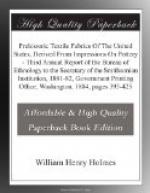It is necessary to distinguish carefully the cord and fabric markings from the stamped designs so common in southern pottery, as well as from the incised designs, some of which imitate fabric markings very closely.
I shall present at once a selection from the numerous examples of the fabrics restored. For convenience of study I have arranged them in six groups, some miscellaneous examples being added in a seventh group. For comparison, a number of illustrations of both ancient and modern textiles are presented.
In regard to methods of manufacture but little need be said. The appliances used have been extremely simple, the work in a vast majority of cases having been done by hand. It is probable that in many instances a simple frame has been used, the threads of the web or warp being fixed at one end and those of the woof being carried through them by the fingers or by a simple needle or shuttle. A loom with a device for carrying the alternate threads of the warp back and forth may have been used, but that form of fabric in which the threads are twisted in pairs at each crossing of the woof could only have been made by hand.
The probable methods will be dwelt upon more in detail as the groups are presented. In verifying the various methods of fabrication I have been greatly assisted by Miss Kate C. Osgood, who has successfully reproduced, in cotton cord, all the varieties discovered, all the mechanism necessary being a number of pins set in a drawing board or frame, in the form of three sides of a rectangle, the warp being fixed at one end only and the woof passing back and forth between the lateral rows of pins, as shown in Fig. 74.
First group.
Fig. 62 illustrates a small fragment of an ordinary coffee sack which I take as a type of the first group. It is a loosely woven fabric of the simplest construction; the two sets of threads being interwoven at right angles to each other, alternate threads of one series passing over and under each of the opposing series as shown in the section, Fig. 63.
[Illustration: Fig. 62.—Type
of Group one—portion of a coffee
sack.]
[Illustration: Fig. 63.—Section.]
It is a remarkable fact that loosely woven examples of this kind of cloth are rarely, if ever, found among the impressions upon clay or in the fabrics themselves where preserved by the salts of copper or by charring. The reason of this probably is that the combination is such that when loosely woven the threads would not remain in place under tension, and the twisted and knotted varieties were consequently preferred.
It is possible that many of the very irregular impressions observed, in which it is so difficult to trace the combinations of the threads, are of distorted fabrics of this class.
This stuff may be woven by hand in a simple frame, or by any of the primitive forms of the loom.
In most cases, so far as the impressions upon pottery show, when this particular combination is employed, the warp is generally very heavy and the woof comparatively light. This gives a cloth differing greatly from the type in appearance; and when, as is usually the case, the woof threads are beaten down tightly, obscuring those of the web, the resemblance to the type is quite lost.




